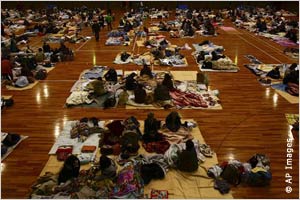2011-03-17 | Japan's Nuclear Danger Zone Widens; More Experts Work the Crisis
- Translation:
- 中文
Japan's Nuclear Danger Zone Widens; More Experts Work the Crisis
17 03 2010

Families evacuated from the danger zone around the Fukushima plant try to rest on the floor of a center. (Photo: AP Photo)
By Charlene Porter
Staff Writer
Washington — The Japanese government is telling citizens within 30 kilometers of a damaged nuclear power plant to stay indoors to protect themselves. The March 15 advisory said people near the Fukushima Daiichi Nuclear Plant should attempt to prevent exposure to the colorless, odorless radiation that escaped from reactors.
The warning followed a March 12 government-ordered evacuation for people within 20 kilometers of the plant.
At the same time, the government has reported to the International Atomic Energy Agency (IAEA) that radiation levels around the damaged plant are falling. Measured at a point between two of the damaged reactors early on March 15, ambient radiation delivered a dose of 400 millisieverts (mSv) per hour. IAEA characterizes this as a “high dose-level,” compared to the 3 mSv annual dose that a person receives from natural sources in the environment, such as radon gas. A chest X-ray exposes a person to 0.1 mSv of radiation.
Results of tests taken hours later showed declining radioactivity levels.
As safety precautions are heightened around the reactor and monitoring continues, U.S. and international officials are boosting their commitment to help. The U.S. Nuclear Regulatory Commission (NRC) has sent eight more experts to Tokyo to lend their expertise to the containment of the power plant. Two NRC reactor experts were deployed initially after the March 11 earthquake.
In a continuous stream of updates on the crisis, the IAEA has pledged its direct support and coordination of international assistance. The Geneva-based agency takes on that role in keeping with an international convention on nuclear accidents.
Earlier March 15, Tokyo Electric Power Company (TEPCO), the plant operators, fought a fire that occurred in the spent-fuel storage pond at the Unit 4 reactor. The pond reportedly spewed radiation directly into the atmosphere. In the Unit 2 reactor, an explosion occurred, the latest in a series of explosions caused by hydrogen build-ups since the earthquake and tsunami caused the failure of the critical plant-cooling system and two back-up systems. The IAEA reports that the reactor containment building may have been damaged in this most recent explosion, but the agency reports confidence that containment buildings on units 1 and 3 are still sound.
RESCUE, RECOVERY, REBUILD
Malfunction at the Fukushima Daiichi Nuclear Plant keeps a sharp edge on this four-day old catastrophe, but the painful work begins to count the dead and the missing and to begin cleanup and rebuilding. The number of confirmed dead approached 2,000 March 15, but many people remain unaccounted for. Some estimates project that total fatalities will mount to 10,000.
The accounting of property damage is likewise incomplete, but some preliminary figures are calculated by the National Police Agency. Almost 60,000 buildings were damaged or destroyed, as well as more than 700 roads, 26 bridges and eight railways in northeastern Japan.
The Ministry of Defense reported March 14 that it will deploy some 100,000 people in search-and-rescue activities, with more than 60,000 already combing through the rubble in search of survivors.
Two search-and-rescue units from the United States are among that number. The teams, from Los Angeles County, California, and Fairfax County, Virginia, have established a base of operations for their 144 personnel and 12 trained search dogs.
A status report from the U.S. Agency for International Development (USAID), which is leading the U.S. component of the humanitarian assistance effort, says that the government of Japan has accepted offers of assistance from 15 countries, including search-and-rescue teams from Australia, China, New Zealand, South Korea and Singapore.
Millions of households remain without power or adequate supplies of natural gas. TEPCO has suspended plans to impose rolling blackouts.
ASSISTANCE FLOWS
Meanwhile, Americans watch the catastrophe unfold with sympathy and compassion. The Council of Philanthropy, a national clearinghouse on charitable activities, reports that people in the United States so far have pledged $24 million to groups providing assistance. The American Red Cross reported March 15 that it has given an initial $10 million to its Japanese counterpart, which is “playing a critical humanitarian role and comforting the survivors,” according to David Meltzer, senior vice president of international services at the American Red Cross.
Secretary of State Hillary Rodham Clinton, attending a meeting in Paris, issued a brief statement after a meeting with Japanese Foreign Minister Takeaki Matsumoto, who thanked the United States for its support and encouragement.
Clinton responded, “Japan is always a very generous donor to any disaster anywhere in the world, and today, the world comes together to support Japan in its hour of need.”
- Translation:
- 中文